Lander Treadmill Desk Review
- Lab tested
Like most reviews sites, our editorial staff and laboratory testing expenses are partially offset by earning small commissions (at no cost to you) when you purchase something through those links. Learn More

Overview
| Review Summary |
There simply isn’t a more sophisticated, reliable, quiet, and stable treadmill desk in the market today than the Lander standing desk coupled with iMovR’s newest Unsit treadmill base. iMovR offers optional 6″ height extenders on all its standing desks specifically for very tall users and office treadmill users (the treadmill’s step-up height is 5″), which makes the Lander the highest-reaching and most stable desk on the market, which is essential for keeping your monitors from shaking as you walk and type. The Lander’s gesture-based height controller is intuitive and sleek and connects to your smartphone via Bluetooth for extra features like a built-in “health coach.” The desk comes in literally thousands of customizable choices of desk size and decor, including 24 ultra-durable 3D-laminate finishes and 38 artisan-handcrafted solid wood options. The new Unsit treadmill base is the quietest ever made, with a super hush 42.9 dB sound signature. Industry-leading warranties on both the desk and treadmill reflect the quality and durability of their components. The Lander is made in the USA and assembles in 3 minutes with no tools. The Unsit treadmill is made in Taiwan (not China) and also installs in minutes, no tools required. |
|---|---|
| MSRP / List Price |
$4,320 |
| Street Price |
iMovR Lander Desk starts at $1,330 or $1,660 if adding the built-in SteadyType option. |
| Shipping |
Free shipping in the continental United States. |
| Warranty |
The made-in-USA Lander Desk has a 15-year warranty on the mechanism and 3D-laminate desktops. The warranty on solid wood desktops is 5 years. |
| Lift Type |
Dual precision-motor lifting columns, dual-stage |
| Transit Speed |
1.6 inches-per-second for height changes |
| Controller |
Desk controller is a “gesture style” paddle with built-in Bluetooth for connecting to the smartphone app. |
| Sizes Available |
In both 3D-laminate and solid wood, the Lander desktops are 1-1/8″ thick and ergo-contoured all around, with a 30″ depth. |
| Colors Available |
24 desktop colors in 3D laminate |
| Construction |
Both the Lander desk and the Unsit treadmill use the heaviest gauge steel of any standing desk and office treadmill on the market, which adds to their weight but this is the key to optimizing stability in a walking desk application. Key components are built by precision robotics. |
| Adjustment Range |
Height range: 24.5″-50.5″ (optional height extenders add 6″) |
| Weight Capacity |
Max load on desk (including desktop): 360 lbs. |
| Walking Belt Size |
20″ x 40″ |
| Top Speed |
2.0 mph |
| Horsepower/RPM |
2.0 HP/ 4000 RPM |
| Noise Level |
Treadmill: 42.9 dB |
| Connectivity Features |
Bluetooth for connecting to apps to control both the desk and the treadmill |
| Power Consumption |
Treadmill: 1.5A at 2.0 mph with 170 lb user. 600W power supply. |
| Typical Assembly Time |
The Lander Desk is extremely well packaged for safety in transit; removing from packaging takes much longer than assembling the desk. Actual assembly of the desk takes only 3 minutes and requires no tools. |
| ANSI/BIFMA Certified |
The desk is certified by an independent lab to the gold standard for commercial grade standing desks, ANSI/BIFMA X5.5. |
| NEAT™ Certified by Mayo Clinic |
Yes |
| Competition |
Compare to All Top-Rated Office Treadmill Desks
|
| Where to buy |
Buy on iMovR |
Rating
| Ease of Assembly | |
|---|---|
| Stability | |
| Safety | |
| Reliability | |
| Customer Experience | |
| Quality and Aesthetics | |
| Ergonomics | |
| Innovation | |
| Value | |
| Suitability for Treadmill Desking | |
| Positives | The most technologically advanced and stable standing desk on the market today, the iMovR Lander paired with their Unsit office treadmill is the very best walking workstation to be had, bar none. Customizable with thousands of shape, size, and color combinations, the entire workstation assembles in under 10 minutes once removed from packaging. Intuitive "gesture" height controller, Bluetooth control of both the treadmill and the desk, exceptionally quiet operation, and industry-leading warranties are just the beginning. The option of adding the patented built-in SteadyType keyboard tray is a game changer in terms of typing comfort and accuracy while walking. While the Lander standing desk comes as small as 41"-wide, to fit the under-desk walking base, the smallest size you can use is the 53"-wide variant. Widths are in 6" increments going all the way up to 95" (and even large L-desks and U-desks are available in the Lander line). You can even configure the Lander as a "sit-stand-walk workstation" with room for an office chair side by side with the treadmill base, when ordering any size over 83". |
| Negatives | High price to match the quality and performance. iMovR does offer less expensive treadmill desk systems based on the Lander Lite and Jaxson desks. The under-desk treadmill weighs 162 lbs and thus requires two people to maneuver in and set up (or you can upgrade the delivery to have someone do this for you). While the treadmill's controller is diminutive on the desktop it lacks the usual readouts in the console, which you have to access on your smartphone. |
Bottom Line
State-of-the-Art Defined
A treadmill desk is empirically the pairing of a standing desk with an under-desk office treadmill. The following review therefore is divided into two sections, firstly the Lander Desk and secondly the iMovR Unsit treadmill base.

iMovR has made many standing desk models designed specifically for use with an office treadmill over the years, all of which you can find in our review archives. However, since 2018 the Lander desk has been by far their most popular desk line for pairing with a treadmill. The reasons are that it’s the most stable (i.e. heaviest metal base), highest-reaching (56″ with the optional 6″ leg extenders), and can be ordered in widths of up to 95″ (as well as L-desk and U-desk configurations) so that you can build a true “sit-stand-walk” workstation with a full-sized office chair side-by-side with the treadmill if you want.

The Lander is also the only iMovR desk line that offers their patented SteadyType ergonomic keyboard tray as a built-in option as opposed to an add-on. If you don’t want to lose the desktop real estate, you could go for a Steady Exo or upcoming SteadyType Slide add-on tray instead. (The Exo works best with 24″-deep desks—see the Lander Lite line for those options—whereas the new SteadyType Slide is a fully-retractable version mounted on slide rails underneath the desktop.) As for the veteran treadmill deskers in our office, some of whom have been working while walking for 15 years or more, none would consider using a desk without a SteadyType keyboard tray from an ergodynamics standpoint. The fact that SteadyType can now be added to any standing desk also means that iMovR’s other desk lines (Lander Lite and Jaxson) can be just as capable and ergonomically tuned for the treadmill desking application, and these are certainly less expensive models.
As for the treadmill base, from 2016-2022 iMovR produced our top-rated unit, the ThermoTread GT, which was the first and only true “enterprise class” office treadmill made. Unfortunately iMovR had to stop producing the ThermoTread at the end of 2022 for supply chain reasons, however the good news is they partnered with former competitor InMovement to bring the Unsit Treadmill Base to its customers. You can now configure any iMovR standing desk with the Unsit, creating the very best combo workstations available in the market today. The Unsit is the quietest treadmill base we’ve ever seen, and has about 50% more walking area than any other model while at the same time taking less floor space in your office, because it’s only 40″ long instead of the usual 50″-70″ long base length.
As treadmill desk combos go, the iMovR configurations are available in literally thousands of customizable versions, setting them in a league of their own against the competition, which these days is pretty much just the Lifespan treadmill desks. Last time we looked, there were 72 different desktop finish options on the Lander (and Lander Lite), in dozens of sizes to match any office space and decor imaginable. iMovR’s desks are also far more stable because they simply use far more metal in their bases and can reach 6″ higher than other desks by adding leg extensions. This increases the overlap between the telescoping tubes of the dual stage bases by an extra three inches for each, thus giving the lifting columns more deflection stability. Since a treadmill base adds 5″-6″ of step-up height to the user, this is really essential for ensuring error-free typing and minimizing monitor shake.
The Lander Desk
The Lander Desk from iMovR bristles with evolutionary enhancements, and it brings not one, but two new revolutionary developments to the fore, putting a significant distance between iMovR and its nearest competitors. We expect nothing less from iMovR, which introduced their stunning, ultra-durable, healthcare-grade 3D laminated surface finishes in 2014 and revolutionary SteadyType® ergonomic keyboard tray for standing desks in 2015. In 2019 they added 38 species/stain options in luxurious real wood, just for the Lander and Lander Lite desk lines, raising the bar substantially in the contest for “the best standing desk money can buy.”
Also in 2019 iMovR added the Lander L-Desk line, revolutionizing the assembly effort required to build a sit-stand L-desk from a typical 90-minute, 2-person operation to an 8-minute, single-person assembly with just eight screws to turn (see video). Like the two-leg Lander, the 3-leg l-shaped desk comes in dozens of 3D laminate and hardwood options. A lot of people use a Lander L-desk with built-in SteadyType as their treadmill desk. In 2021 iMovR introduce the Lander U-desk, which offers up to a whopping 43 sq ft of desktop real estate, making it the largest standing desk made. While we don’t recommend this configuration so much for treadmill desking since the only way off the treadmill would be to step off backwards, it does illustrate the versatility of the Lander Desk platform. Any Lander desk can actually be upgraded to an L-shape or U-shape in the future, without having to get a whole new desk.
In keeping with their reputation as the most innovative standing desk manufacturer, Seattle-based iMovR spent more than two years developing the Lander Desk. Their simple aim: to eliminate the No. 1 hesitation people have about switching to a standing desk, the hassle of assembling a 200-pound desk by themselves, and the fear of an inconvenient disruption to their work should anything go wrong during assembly.
The Lander, and its new sister products, the Lander Lite, are two of only three standing desks you can buy online that have earned ANSI/BIFMA X5.5-2014 certification, the gold standard for “contract furniture,” i.e. commercial-grade quality, durability, reliability and performance.
In other words, their aim was to make the most reliable electric standing desk ever, as well as the easiest ever to assemble. In this review, we’ll see just how well they did at hitting that mark.
Assembles in Minutes, No Tools Required
This goal iMovR indeed achieved with flying colors, legitimizing the claim behind the name “Lander” – that is, this desk can be plugged in and used within minutes of landing at your doorstep. Whereas all other standing desks are essentially “IKEA kits,” the Lander is so easy to put together even a kid could do it — or a business exec wearing an expensive suit, or heels and skirt — without the use of any tools. There is no need to get down on the floor to futz with Allen keys and screwdrivers, and no chance of accidentally installing the wrong bolt or destroying a desktop by putting the wrong length screw through it.
The trick? The Lander’s frame, leg sockets, and controller are already attached to the bottom of the desktop. All the cables are neatly tacked down, and everything has been factory-tested before shipping to ensure a successful installation each and every time.
The steps to assembling a Lander desk are simple (as you can see in the video). The connection is remarkably solid and perfectly aligned, as stable as any desk we’ve ever assembled with four to six bolts holding each leg in place.
Is the “98 percent factory pre-assembled” claim legit? Once you remove the desktop and legs from their ample protective packaging, and assuming you’ve already watched the very short assembly video, then, yes, it should indeed take you only a couple of minutes to have your desk ready to flip over and start using.
The instruction manual will do if you haven’t watched the video. There is a QR code and link on the instruction manual that takes you to a page describing how to use the smartphone app (iOS and Android are supported)— since it is something that will be updated often — but, it’s a refreshingly simple app and frankly we never needed to reference any documentation to figure out how to use it.
For buyers of a 59” or wider desk the crossbar makes for a very convenient channel for running some of your computer cables through to keep your desk looking tidy. This feature isn’t touted by iMovR because their smaller-sized desks don’t have this style of crossbar, but there’s no reason not to take advantage of it. Of course, iMovR also sells more robust cable management kits for those who have more gear to deal with.
Disassembly is almost as easy, requiring only a screwdriver (used as a lever) to pop the clamps off. After that, it’s the same process in reverse, taking only minutes to fully disassemble the iMovR Lander Desk. That can come in very handy if you ever need to move your desk to another home or office in the future, which can be a bear of a task with most any other desk, requiring tools, time, and the instruction manual, wherever you left it.
iMovR’s Lander, Lander Lite and Lander L-Desk lead the pack of Quick-Install Standing Desks in the industry, all able to be installed in eight minutes or less after removing from packaging.
When we first reviewed the Lander, iMovR had no plans to offer the base standalone, as it was designed specifically for factory pre-assembly. However, the Lander’s other features had the DIY community banging on their door for a standalone base kit, and so we’ve given it the full work-up. Check out our Lander Standalone Desk Base Kit review.
Look Ma, No Hands!

With the Lander’s ultra-sleek “height paddle” you don’t need to grope around searching for the right button to press or avert your eyes from your work just to change your desk’s height. Two taps upwards or downwards on the paddle will command the Lander to move up or down to the next “favorite” position (out of four programmable heights). The hi-res display in the paddle shows your height changing with the precision of 1/10th of an inch (or centimeter) in a crisp, easy to read font.
But hold on a minute. If you’ve read our standing desk reviews before then you know that electric standing desks sold in the US require you to keep your finger on the up or down button the entire duration of the height change. There’s only two ways around this requirement for UL Safety Certification. One, is to buy a cheap foreign-made unit from a manufacturer that doesn’t care if they get sued for product liability in the US. The other, is to put a Bluetooth transceiver into the desk controller and tie it to an app on your smartphone, where you can click off a liability waiver which gives you the option to switch from sitting to standing with a single tap. And that’s exactly how iMovR pulled it off with the Lander.
We recommend clicking off on the waiver the moment you sync up Bluetooth with your desk and enjoying this unique feature with complete confidence as the US-made base comes with built-in collision detection.
A Helpful Health Coach, Built-in
Several desks have appeared on the market in recent years with built-in reminders to coax you out of your sitting lulls and make sure you’re reaching your own standing-time goals every day. Some of them can be hard to figure out how to program without an instruction manual, and some can buzz loudly and annoyingly when they trigger.

With the Lander, these notifications can be easily programmed from the smartphone app (or using one of the three hidden buttons on the hand paddle). You are alerted when the perimeter of the hand paddle pulses slowly in color or via phone vibration once you connect to the app when it is time to stand.
While simple and easy to set up, we do expect to see more features added to the free smartphone app over time, based on what we hear from iMovR’s engineers. For now, the main functions include setting your height favorites and notification periods — both of which you can also do using the hidden buttons on the hand paddle. We hear iMovR is working on adding upcoming features like use pattern charting and sharing calorie burn data with your wearable device.
Lander is Proudly Made in the USA
In the past, iMovR was known for making their advanced 3D-laminated table tops in Michigan but offering both top-quality American-made and lower-cost bases as options on their desks.
With the launch of the Lander, iMovR has decided to go exclusively made-in-USA on their electric desk lines from now on. They have sunsetted their UpTown, Olympus, Ellure and Denali desk lines, which employed relatively high-quality, albeit Chinese-made bases, to focus on the more robust, longer-lasting, and better-performing American-made components.
Indeed, in reviewing countless standing desk models, we have not found any bases from China with the combination of lift capacity (360 pounds), transit speed (1.6 ips), anti-collision technology that detects tilt, and hushed noise signature offered by the iMovR Lander, much less with Bluetooth and a smartphone app.
Electric bases in this performance range are the province of a few American and Scandinavian manufacturers that make bases for the likes of Steelcase and Hermann Miller, usually found in shockingly expensive desk lines only sold to large corporate or government buyers. As a brand, iMovR’s American-made standing desks may be pricier than the commodity Chinese-based desks you’ll find online, but they’re still a fraction of the cost of the less technologically advanced but ubiquitous desks from companies like Steelcase.
Why Quality Matters
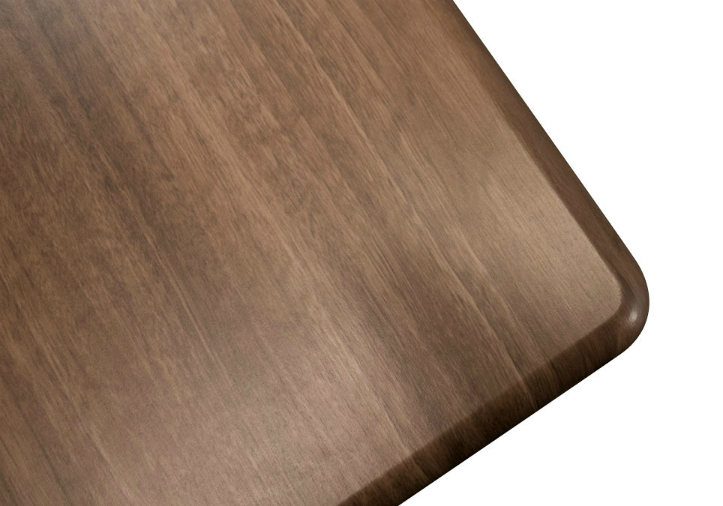 With something like a standing desk, a product that will endure many “cycles” over its lifetime, as with an automobile or aircraft, precision manufacturing is the key to trouble-free operation and longevity. The precision-machined parts and advanced alloy materials that keep the telescoping legs moving smoothly and efficiently will eventually wear out one molecule at a time, leading to a wobbly, squeaky desk, higher strain on the motors and higher current draw, and potentially, motor failure. This technology isn’t easily replicated by factories focused on commodity production.
With something like a standing desk, a product that will endure many “cycles” over its lifetime, as with an automobile or aircraft, precision manufacturing is the key to trouble-free operation and longevity. The precision-machined parts and advanced alloy materials that keep the telescoping legs moving smoothly and efficiently will eventually wear out one molecule at a time, leading to a wobbly, squeaky desk, higher strain on the motors and higher current draw, and potentially, motor failure. This technology isn’t easily replicated by factories focused on commodity production.
The question is whether an electric base is going to potentially fail within the first year of ownership (as hinted by the one-year warranties on some insanely cheap bases made in China) or is designed to last 10 years plus without issues. In other words, making an investment in a premium quality desk like the Lander can cost you less in the long run, because it’ll continue to perform well for many more years, saving you unwanted hassles.
ANSI/BIFMA Certified
Government and large enterprise customers often require ANSI/BIFMA X5.5-2014 Certification on any ergonomic desks that they buy, which is what keeps the “Grand Rapids Mafia” (Steelcase, Herman Miller, et al) in a lock on 40 percent of office furniture sold. iMovR is one of only two standing desk manufacturers that sell online, as opposed to going through contract-furniture dealers, that offer BIFMA-certified products, now that the Lander has earned its certification. Learn more about this subject in our primer on What is ANSI/BIFMA and How Does it Relate to Standing Desks?
At WorkWhileWalking, we pride ourselves in our own lab testing abilities, which, while not as automated as BIFMA testing (which can take 2-3 weeks to conduct, with many thousands of repetitions), has more practical real-world aspects to it. For example, we test the “duty cycle” on each standing desk to see if it matches the spec.
Most desks have a duty cycle of 10 percent, meaning that when fully loaded to the desk’s maximum specified weight-lifting capacity the motors can be run continuously for two minutes before they overheat and get shut down by either a heat sensor or current sensor. They can then take up to 18 minutes to cool down before the desk motors can be activated again. The Lander is the first desk we’ve ever tested that exceeded two minutes, going five minutes without shutting off the motors — under a full load of 360 pounds. At that point, it only required a few seconds of cool-down before the motors started running again. That’s impressive.
(To see what goes into a typical ANSI/BIFMA X5.5 certification test take a look at the independent laboratory’s report on the Lander Desk.)
Truth in Advertising When it Comes to “Made in USA”
One final note on this subject of American versus Chinese-made standing desks. For some time now we’ve been observing an unsettling trend among the most popular online sellers of standing desks, claiming that their products are made in America when they don’t factually meet the Federal Trade Commission’s (FTC) definition. We realize that it’s virtually impossible to buy a finished good today, especially with any electronics in it, that is entirely made in one county — be it a refrigerator or a standing desk — but, at least half of the components, by “cost and processes,” must be made in America to meet the FTC’s legal definition of Made in America. Some online sellers either never mention the country of origin of the product or talk only about their tabletops being made in America, luring the consumer away from realizing the fact that the base is entirely made in China. This includes popular brands like Fully and UpLift, which don’t like to disclose that they exclusively use Jiecang bases.
As part of our ever-evolving review process we now ask manufacturers to fully disclose the country of origin of their products, because many of our readers really want to know. In the case of the iMovR Lander, the tabletops, feet and leg extensions are made in Michigan, the lifting columns are robotically manufactured in Kentucky, the receiving sockets and crossbar are presently made in Denmark, and only the smallest component—the hand controller—is marked “Designed in Denmark, Made in China.” That certainly exceeds the 50 percent threshold, setting the Lander apart from 95 percent of standing desks being sold online today.
Personalized for You and Built On-Demand
Like all iMovR Desks, the Lander is completely customizable with a vast array of size and color choices, then produced on-demand (“Dell style”) and shipped out within one week of order. The ergo-contoured, 3D laminated surfaces give the desk the look of natural hardwood and are hermetically-sealed — down to the grommet holes — ensuring it will look great and perform great for years. (We’ve left one of iMovR’s 3D laminated tops outside our lab in the Seattle rain for two years, and it still hasn’t shown any signs of water damage!)

The Lander comes in at least 24 standard 3D-laminate colors as iMovR’s other desk and table products (the selection of colors seems to increase every year). A few years ago iMovR added the option of solid wood tops with at least 38 stunning species and stain combinations. It doesn’t get any finer in the standing desk arena than these new natural wood tops. (For a deeper dive on desktops be sure to check out our primers on The Ultimate Guide to Desk Top Materials for Standing Desks and Comparing All Real Wood Standing Desk Options.)
Table widths include 41”, 47”, 53”, 59”, 65”, 71”, 77”, 83”, 89”, and 95” for the popular 30”-deep version — more size options than any other desk sold online.
The bases are painted with a high-quality powder coat finish, with standard color options being black, white or silver. As with the desktops, iMovR does offer even more custom colors for large bulk orders.
Also available are 6” leg extenders. The Lander already has an excellent top-end height of 50”, but with these extenders, the Lander can tower up to 56”— ideal for tall users and for average-to-tall users who intend to use an office treadmill underfoot. The Lander is one of the most rigid, stable desks we’ve ever tested, but if you’re taller and you use a lot of equipment on your desk, you might consider adding the leg extenders just to enhance stability even more (by increasing the overlap area at the ends of the telescoping tubes). So far iMovR is still the only standing desk manufacturer to accommodate the extra-tall market and treadmill deskers with these clever extenders.
Other customization options include caster wheels, a wide array of standing mats, and every combination of monitor arms you can imagine. To round out your ergonomics, we always recommend a keyboard tray, of course, and with the Lander, you have two excellent options. Add the built-in SteadyType® for the ultimate neutral typing postures. Or, easily install iMovR’s new Trackless Ergonomic Keyboard Tray using the pre-drilled holes on the underside of the desk.
Warranty and Shipping
The Lander comes with an industry-leading lifetime warranty on the frame and a 15-year warranty on the motors and electronics, as well as a 100-day satisfaction guarantee.
While some of the Chinese-made competitors like UpLift and Fully (both using a lifting base manufactured by Jiecang) have upped their warranty terms to seemingly match iMovR’s, consumers should be aware that not all warranties are created equal. Some insert a bevy of carve-outs in the fine print that might leave you out in the cold if ever you run into a component failure in the future. In fact, there’s so much spin going on in warranty terms marketing claims these days that we had to write a separate primer just on How To Compare Warranty Policies Between Standing Desk Manufacturers, which we encourage the consumer to read ahead of making their final purchase decision.
Our staff experts’ advice is to always go with the higher-quality componentry of a top-shelf American or European-made base and significantly reduce the odds of ever having to deal with the hassle of an out-of-commission desk.
Shipping to the lower 48 states is included in the price. Inquire through iMovR.com to get freight quotes for AK, HI, Canada and International. The Lander comes in two boxes with the legs arriving in a separate box from the desktop, making it easier to move. iMovR also has a QuickShip program in which it pre-manufactures desks in four popular sizes and four colors (both 3D laminate and solid wood) so they can ship immediately after an order.
Futureproof Design

The Lander is clearly more future-proof than any other standing desk we’ve had the pleasure of testing. There have been some gimmicky predecessors that had an iPod built into the desktop (e.g. the Stir Desk) or a smartphone app (e.g. the Autonomous SmartDesk 3). The Lander is the first desk we’ve seen to put together the bluetooth connectivity, smart-phone app and working notifications with true ease of use on a top-tier mechanical platform.
All this comes at somewhat of a premium price, naturally. While the Lander isn’t the cheapest desk on the market, given its premium components, the value is clearly there. Desks built this well tend to last longer and justify their higher price through lower cost of ownership.
If you’re on a budget, yet still want to buy American and not chintz on the cool technology advancements of the Lander, there’s good news.Fifteen months after the introduction of the Lander Desk, iMovR released a new “light” version of the desk with a performance range and price point that’s more suited to the mainstream user. Starting prices on the Lander Lite are about $400 less than the original Lander, so it’s definitely worth checking out. See our complete lab-tested Lander Lite Standing Desk Review.
See how all the Lander variations stack up against other Quick-Install Standing Desks.
The iMovR Unsit Treadmill Base
Moving on to the treadmill base portion of this review…
Our New Top Pick in Office Treadmills
Much has been written by our treadmill desk experts over the past decade as we witnessed no fewer than eighteen different brands enter the fray. From the OG Steelcase Walkstation, first launched in 2007, to the iMovR ThermoTread GT that held our top rating for the past six years, we’ve seen more than 20 models pass through our testing labs. Sadly, all but a handful of these remain in production today, leaving the prospective treadmill desk buyer with very limited options.

With iMovR’s recent announcement that they have suspended the production of the ThermoTread GT, the only two models in the market even remotely in the same league are the Unsit Treadmill reviewed here and the Lifespan TR5000-DT3 (aka “TR-5000 Glowup”). iMovR and InMovement have joined forces to bring the Unsit to a much wider market and to pair it with iMovR’s standing desks, which like these treadmills, were specifically designed for the rigors and ergonomic requirements of treadmill desking.
The new partnership has resulted in a wide range of treadmill desk options, far more than any other company’s. We recently received a fresh Unsit treadmill base from iMovR to check out the latest version of the product, since our original review was conducted all the way back in 2017. We’ve completely put it through its paces and are pleasantly surprised by how novel the design is, and how well built this walking treadmill is.
The Unboxing Experience
The unit arrived in an impressive amount of packaging, firmly strapped to the shipping pallet. We shot the following unboxing video to give you a good idea of the effort that will be required to get the unit over to where you want it and setting it up. You’ll want to be sure to have a friend, if not two, on hand to help you maneuver this 162lb beast. Alternatively, you can purchase a delivery upgrade to have someone else do it for you.
Unconventional Dimensions
If you’ve been a subscriber to the WorkWhileWalking newsletter, you’ve probably noticed over the years that we have a strong bias against made-in-China treadmills with harrowingly narrow walking belts, like 14″-16″. With the exception of a few trashy exercise treadmills sold on Amazon, which aren’t really designed for treadmill desking (despite the insertion of “treadmill desk” keywords in their marketing copy), those units are pretty much gone now. And good riddance. Walking on a belt that’s too narrow for hours on end can grind arthritic ruts into your hip sockets. You need a little latitudinal freedom of movement to keep your walking muscles and joints limber and healthy.
When iMovR introduced the Thermotread GT in 2016, with its 20 inch-wide belt, this clearly became the optimal width. No more accidental stepping on the treadmill’s side rails while walking. And the entire unit was still slender enough to fit under a standing desk side-by-side with a standard office chair. Even Lifespan Fitness eventually copied iMovR and updated all their designs with a 20″ belt width a few years ago.

The original designers of the Unsit, however, felt that if 20 inches was good, then 30 inches would be even better. They widened the tread belt by 50%, while at the same time cutting its length by 20%. Since the deck behind you isn’t really walking space, they argued that their design has “55% more walking area than the typical treadmill,” which is a pretty reasonable claim. An additional argument was that the extra width would allow the user to shift left and right as needed to answer the phone or pick up a writing pad, without accidentally stepping on a side rail. Lastly, by shortening the deck by 15″-20″ compared to other models, they argued that they’ve reduced the potential for tripping over your treadmill accidentally. We’ve all done it from time to time, so yeah, we’ll buy that argument as well.

There are a few consequences that come with the non-standard roller, deck, and belt widths that should be noted if you’re considering buying an Unsit office treadmill base. First is the price. The Unsit uses non-standard parts, which cost so much more to produce, which makes it the most expensive unit on the market today—even more than the enterprise-class iMovR ThermoTread GT when it was last available. Second, it requires a standing desk with at least 40″ of spread between the lifting columns. For most brands, that’s going to mean a 60″ desk or greater (within iMovR’s desk lines you can go down to 53″).
In fact, the only standing desk made that has enough room between the legs to accommodate both the 39 inch-wide Unsit unit and a standard office chair is iMovR’s own Lander Desk in an 83″, 89″ or 95″ width. We set one up in our studio here with a SteadyType Exo keyboard tray and full-size office chair so you can get an idea of what this kind of “sit-stand-walk” workstation would look like.
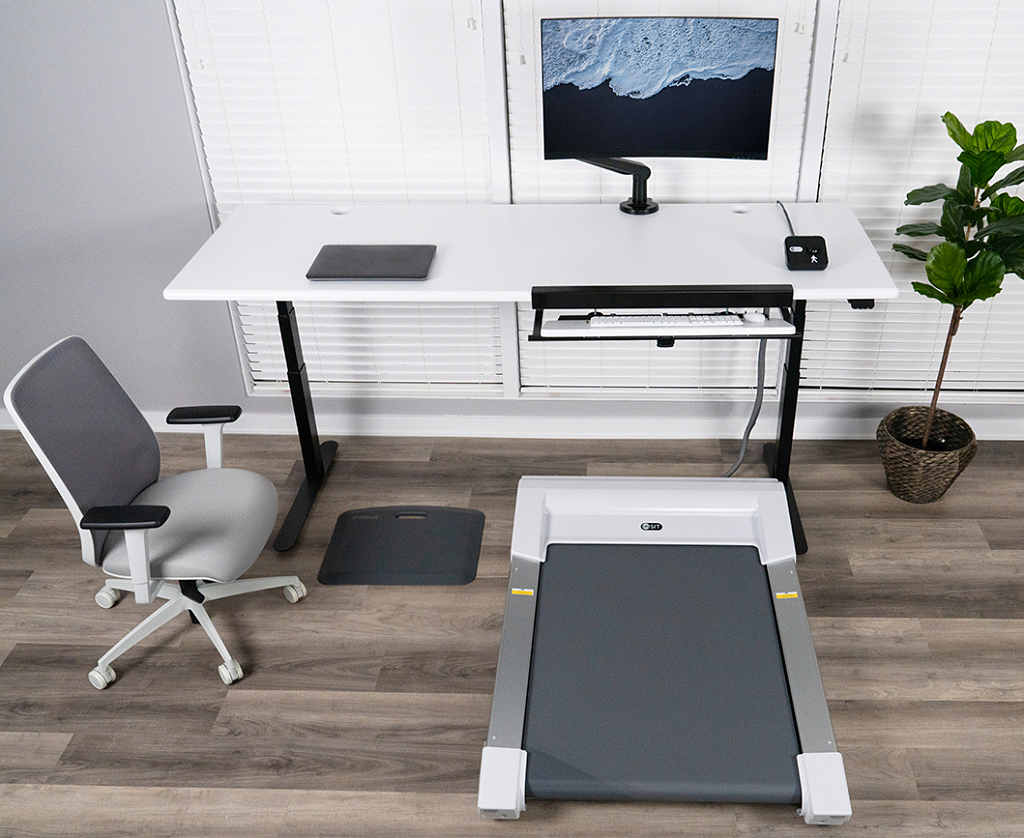 The Unsit treadmill base shown here in a “sit-stand-walk” configuration on an iMovR Lander 83″ desk, equipped with a SteadyType Exo keyboard tray for treadmill desking.
The Unsit treadmill base shown here in a “sit-stand-walk” configuration on an iMovR Lander 83″ desk, equipped with a SteadyType Exo keyboard tray for treadmill desking.

When it comes to switching up your work mode, another way to go is to plant an ergonomic seat, like the Tempo Treadtop Stool or Tempo Treadtop Chair, on top of the treadmill whenever you’re done walking and standing, and just want to sit. Read our compilation of ergonomic seating reviews to find one that you can set directly on the treadmill deck. We also highly recommend a treadtop anti-fatigue mat for standing, since the hard deck can be a bit harsh to stand on for long periods. iMovR makes a 20″x32″ EcoLast Economy Standing Mat that’s a perfect fit for the Unsit base.
Properly Positioning the Treadmill Under the Desk
We have to say upfront that all of us on the review staff are used to working while walking on longer treadmill decks, for many years. So it took some of us a little getting used to walking on such a short deck. If you’ve never been on a treadmill desk before, this will not be an issue for you, but if you’re upgrading from a previous unit with a longer deck, just beware that you won’t have as much time to hop off the treadmill when it stops like you were used to.
The Unsit comes with a couple of decals on the aluminum siderails to show you where the desktop should be positioned if you were to drop a plumb line down to the deck. We found this to be a pretty good location for average sized individuals. If you’re a taller individual with a longer stride length, however, or even if you just have a large gut in front of you (there’s no delicate way of putting that) you’ll probably find that you prefer to have the Unsit a little further away from the wall lest you start feeling that rear roller at the end of your stride.
If you’re getting a treadmill for just yourself to use, this is not an issue. Once you find the sweet spot you’ll never have to move the treadmill again. If, on the other hand, you plan to share the same workstation with other individuals who may have different body types than your own, you may find that you have to reposition the treadmill when you switch users. It’s not that hard to do that, as you just lift the back of the unit like a wheel barrow and roll it on its two caster wheels. Just be sure to use proper lifting techniques. This is one thing the ThermoTread GT had over the Unsit; with its 50″-long deck all users of all strides could use the workstation without ever needing to reposition the treadmill. Again, not a problem if you’re going to be the sole user of the station.
How to Lubricate an Unsit
The extra belt width makes it a bit harder to routinely lubricate the treadmill, as everyone would be wise to do regardless of the make and model (learn more about proper treadmill lubrication). With units like the Lifespan or Thermotread GT, you would simply lift the belt at the edges and spray an ounce or two of 100% silicon oil lubricant under the footfall area, and then walk it out for a few minutes to spread the lube everywhere it needs to go. There’s enough flex in the belt to lift it up easily; all you need for the job is a lubricant bottle with a pinpoint nozzle on it.
The problem with the Unsit’s very wide belt is that you can’t lift it enough to get that lubricant spray everywhere you need it without first loosening the belt. There’s a relatively simple procedure in the Unsit’s instruction manual for doing that, but people are often intimidated by the prospect of having to loosen or tight the belt on a treadmill. It’s a bit tricky because you have to remember exactly how many turns you made on the rear roller adjustment bolt and then make them in reverse, precisely. If you don’t do it correctly the belt may start tracking left or right, and you’ll need to do a full re-alignment.

Luckily, we found a hack around the problem by simply getting a friend to tilt the treadmill on its left side, and then its right side, and just drip the lubricant down between the belt and the deck. It was a lot easier than trying to do it while flat on the ground, and we didn’t even have to loosen the belt at all. After a few sprays we just “walked out” the lubricant for a few minutes to make sure it spread everywhere it needed to go. Voila!
Can you get by without lubricating the treadmill? Every treadmill gradually attracts dust under the belt by virtue of static electricity drawing dirt off of users’ shoes. That dirt builds up over time, increasing friction. As friction increases, the unit makes more noise, draws more power, experiences more pronounced belt hesitation, and eventually scratches up the surface of the deck, leading to even more friction and degradation of the underside of the tread belt. So, continually using a treadmill that hasn’t been properly maintained is definitely not recommended. Left unaddressed long enough, any treadmill will just burn its motor out with excessive friction, if something else doesn’t fail first.
See our review of iMovR’s EasySpray treadmill lubricant for more info on recommended regular maintenance.
Minimalist Controller

There are fancy treadmill bases out there with all manner of desktop touchscreen controllers, including the old ThermoTread GT and the upgraded Lifespan TR5000 with the OmniHub controller. The design of the Unsit has gone in the other direction entirely, with a super-simple desktop controller featuring only a speed knob, which doubles as the stop-start switch, and a ring of LED lights that indicate how fast the treadmill is moving.
Lacking any sort of digital readouts as you’d expect on a treadmill, the only way to get basic information out of the unit—such as time, speed, distance, calories, or step count—is to download the Unsit app. It’s a pretty basic one-screen affair, available for free download on both the Apple and Android app stores.

On the other hand, you might ask yourself how much you need a readout with all that information. People that buy a desk treadmill are likely in the attitude of being more healthy and will want to track all that information to make sure they meet certain goals, especially if they can match it up to a health app they have on a smart watch. However, the first time they leave that watch at home, that tracking then won’t match up with what you actually did and recorded from your treadmill stats. We have found that most people don’t really end up using all that information on a regular basis. They just end up controlling the speed, which Unsit’s controller does. In the end, what really matters is how much time you avoid sitting while you are at the office, and if you are using the treadmill at all, well done.

Of course being a TUV-certified treadmill, the Unsit has to have that obligatory safety clip and lanyard that all certified treadmills are required to include. Should you choose to use it, you’ll need to secure it to the bottom of your desktop with some screws or use the double-sticky tape it comes with. We imagine most home office users will ignore this device, which is arguably senseless to demand users attach to their clothes when they’re walking at 2.0 mph or less. Other treadmill controllers we’ve tested have mostly had that magnetic clip attached to the desktop controller itself, eliminating the need to pull out a drill and screwdriver for installation.
What Is The Real User Weight Rating?
InMovement was marketing the Unsit as being fit for use by users weighing up to 400 lbs., which would put in the same class as the iMovR ThermoTread GT and the LifeSpan TR5000-DT3. As we describe in our primer on Why Treadmill User Weight Ratings Really Matter, most manufacturers make up these figures out of whole cloth, and we strongly suspect that’s the case here. The ThermoTread GT, in contrast, was tested for months on special stress-testing fixtures to validate its 24×7 duty cycle and 400 lb rating.
iMovR made the right call in de-rating the Unsit to 300 lbs. While the Unsit is extremely well built with a solid frame, the motor is only 2.0 horsepower, versus 3.0 HP on the other two models. Now, the ThermoTread GT had a top speed of 2.5 mph, and the Lifespan TR5000 a top speed of 4.0 mph, so the fact that the Unsit tops out at 2.0 mph does mean it can handle a higher max weight for a given horsepower. But with 50% fewer horses than the other two units we needed to put this to the test to feel comfortable with our rating.
We tested the Unsit at some higher weights and indeed began to hear a little moaning out of the motor with every heel strike on the belt when we got up to 275 lbs. Not hesitation, just a little difference in the motor speed, which is fairly normal for a treadmill. After a lot of testing with our review staff, we’re in agreement that 300 lbs should be the correct user weight limitation for this treadmill.
But For Two Leveling Pads
Almost every treadmill we have ever seen has four screw-in “leveling pads,” one on each corner of the base, to allow for the fact that most floors are actually quite uneven. Properly leveling a treadmill when it is first planted on the floor is a hypercritical step. The consequences of not properly leveling a treadmill are that it gets “high sided” on two corners, torquing the frame. This leads to all sorts of damage, the first telltale sign being that users notice a lot of squeaking when they walk and the walking belt will tend to migrate to the left or right edge.

The Unsit unit only has levelers on the two rear corners. The head of the treadmill rests on its caster wheels only. Unlike the ThermoTread GT and other top-end treadmills, the Unsit lacks leveling pads on the front corners. The good news is that the frame is so stiff, and so strong, that it isn’t very likely to get “torqued” unless the floor is egregiously uneven. When leveling any treadmill you want to make sure it is parallel to the Earth both front-to-back and side-to-side.
Even in our newly remodeled offices we couldn’t get the side-to-side aspect of the Unsit perfectly level using only the two leveling feet. This is such a minor angle as to be dismissable, but if your floors are really bad, the way around this issue is to stack thin disks under one of the caster wheels until you can get the treadmill perfectly level both longitudinally and laterally.
Unsit’s Company History
As mentioned above, iMovR partnered with InMovement to bring the Unsit Office Treadmill to its customers after suspending the production of their ThermoTread GT due to supply chain issues. This is a great match as iMovR already makes the best standing desks for use with under-desk treadmills, and while InMovement has the best office treadmill currently in production, it also had a very small market footprint before joining forces with iMovR. In this new partnership, while iMovR is selling the Unsit on its own website, fulfillment, technical support, and warranty service is still being provided by InMovement.
This last part of our review deals with the complicated history of Fort Collins, Colorado-based InMovement. This is more informational for the prospective buyer than anything related to the hardware itself, but we feel editorially compelled to share it.
We have gotten to know Brian Angel, the current owner of InMovement, very well over the past few years. He has proven his commitment to treating customers well and to continue to develop the business around the Unsit treadmill, even though it is only a three-person company now. He’s a straight shooter and his business ethics ride at a much higher altitude than Taiwanese-owned Lifespan Fitness. We do trust that no customer of InMovement will walk away unhappy if they have an issue with the product. Working through iMovR, however, gives customers a better option, with a larger company behind the product, and the greatest depth of treadmill desking expertise in the entire industry.
The original Unsit company launched their Walk-1 treadmill desk into the marketplace in 2017. It was founded by former fitness industry executives in Los Angeles, all of whom had deep histories in treadmill manufacturing and servicing, as well as the commercial gym industry. Alas, that didn’t make them experts in the office fitness market, where the correct pairing of the under-desk treadmill and the standing desk is a critical element of successfully marketing a walking workstation. The company went bankrupt after a few years in business.
Meanwhile, Brian Angel acquired the remnants of another company called InMovement in 2018. InMovement was a failed spin-off from Brunswick’s Life Fitness division selling a variety of office fitness gear like an office treadmill, under-desk pedal units, and standing desk converters. Fast forward to today and the InMovement brand name is now owned by the Angel family. As of 2022, all the remaining inventories of the original InMovement product line have been sold, and the brand and website are the only vestiges that remain.
Angel next acquired the remnant inventory of Unsit Walk-1 treadmills when that business failed, moving it under the InMovement brand and breathing life into the company again. The same factory in Taiwan that was manufacturing the Unsit treadmill for the original company founders is still producing it today.
Speaking of Taiwan, it is well known within the cardio fitness equipment industry that commercial grade products come from Taiwan and consumer grade products come from China. Not surprisingly, the Unsit, like the ThermoTread and Lifespan treadmills, all come from Taiwan. We’ve yet to see any treadmill desk base made in China that wouldn’t fail within 50 hours of use. Another advantage of being made in Taiwan is that tariffs are minuscule compared to the 25% that is layered onto Chinese-made treadmills.
Bottom Line: Unsit Is Our New Top Pick
As we said above, WorkWhileWalking has reviewed every office treadmill that has ever been introduced since the inception of the industry, starting with the Steelcase Walkstation back in 2007, including the top-rated ThermoTread GT, the Lifespan TR800, TR1200 and TR5000 treadmill desks, including the now-defunct TreadDesk, NordicTrack, ProForm, original InMovement, RebelDesk, and Woodway, among others.
The treadmill desk field has attracted a lot of inexperienced manufacturers chasing after some perceived golden opportunity. A decade and a half into it, most of the models introduced failed to thrive due to design shortcomings, and more recently, pandemic supply chain hardships. By 2020 the market had only two dominant leaders, iMovR and Lifespan, that demonstrated the staying power and commercial success to give a consumer or enterprise customer reasonable confidence in the product. Unfortunately, with iMovR deciding to suspend production of their ThermoTread GT in late 2022 due to supply chain challenges, it was down to Lifespan Fitness with its spate of recent departures and quality issues, and the fledgling InMovement. So this tie-up between iMovR and InMovement is a great step toward insuring that a wide variety of high-quality treadmill desk combos will continue to be available in the market.
You’ll have to read our review of the TR5000-DT3 to get the complete picture of how it compares to the standalone Unsit treadmill base, but from the 100,000 foot view, it is just a reskinned TR5000i running treadmill, as has always been the habit of this manufacturer. The underlying guts of the machine are still tuned to running speeds and thus not correctly geared for the much higher strain load of walking on a treadmill versus running on it. The Unsit, in contrast, like the ThermoTread GT, is a clean-sheet design specifically geared for the treadmill desking application.
As for price, the Unsit is the most expensive under-desk office treadmill currently in the market. The realities of the post-pandemic economy are that the costs of shipping containers from Asia have exploded, as have many of the raw materials, chips, and labor, so we’ve seen prices of treadmills go up about 50% since early 2020, across the board. At $2,995 (before promotional discounts) the difference in price between an Unsit and a ThermoTread GT or TR5000-DT3 is pretty small. For the higher quality construction, softer sound signature, wider belt, safety features and Bluetooth sync, we’d say it’s clearly worth it.
Check out all our office treadmill walking base reviews as well as our integrated treadmill desk combo reviews to learn about other options. And be sure to subscribe to our free newsletter to stay on top of the latest developments in the office fitness industry.
Many standing desks and converters come with grommets for some added convenience. Check out our article on grommet holes for everything you need to know about the different ways to use them to enhance your workstation, what to look for in your grommet holes, and where to find the desks with the best ones.

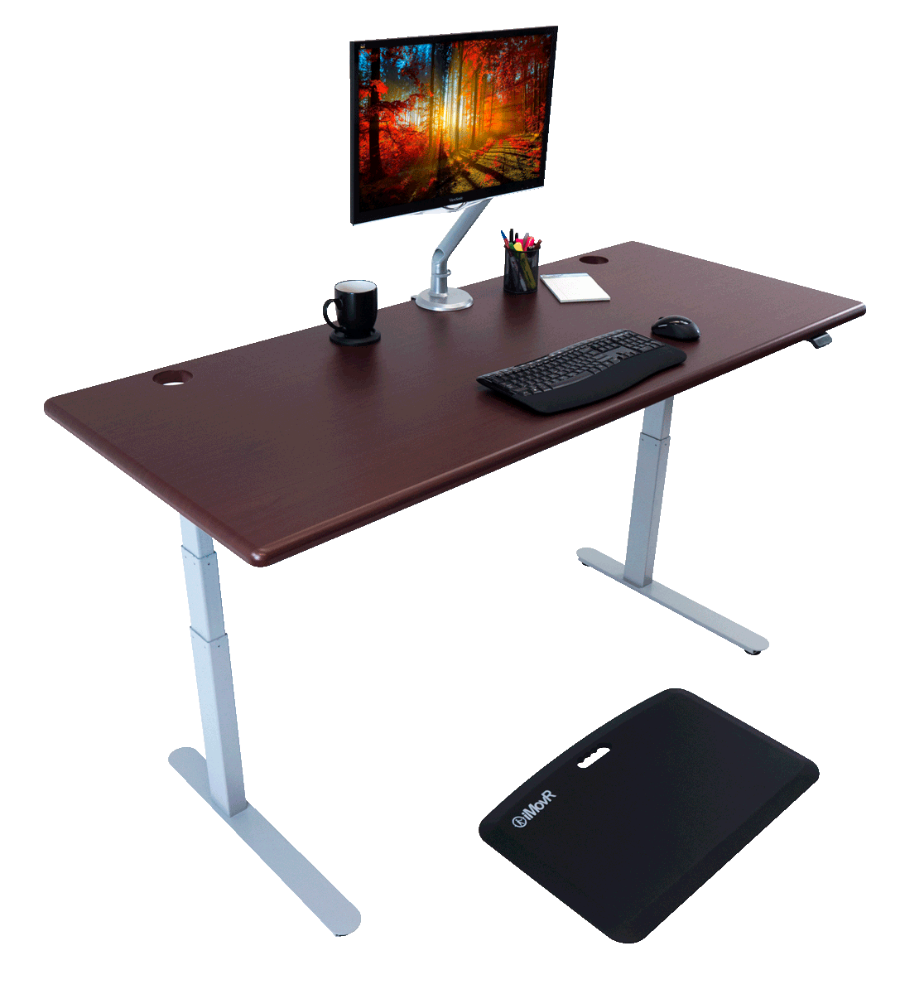

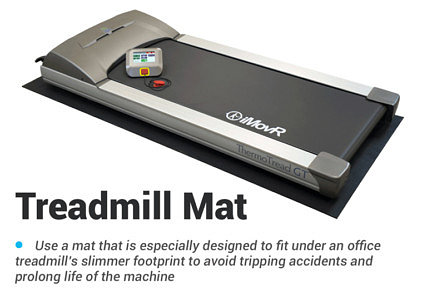

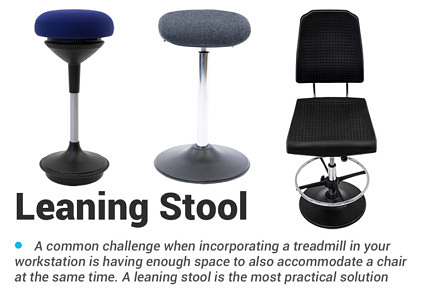
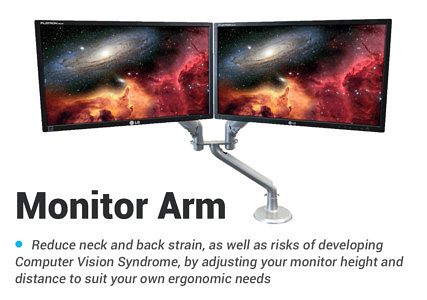
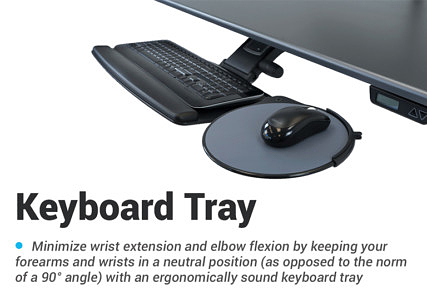
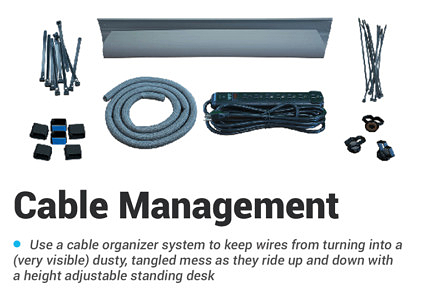
0 Comments
Leave a response >